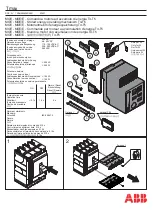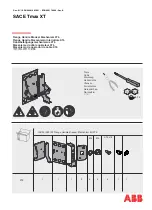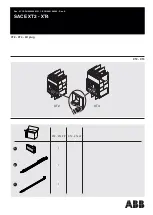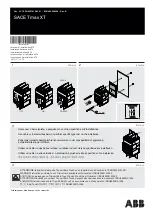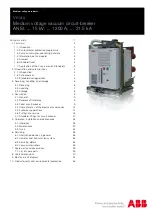
Powered by Safety
®
48
Maintenance
PowlVac
®
STD Vacuum Circuit Breaker
IB-60201
7. Turn the secondary trip prop adjusting
screw counter-clockwise 1½ full turns
from the position noted in step 6.
8. While holding the secondary trip
prop adjusting screw from turning,
securely tighten the secondary trip prop
adjusting screw locking nut.
9. Manually charge the main closing
spring using the manual charge handle
per
Ch 4 Installation
,
d. p
lAcInG
the
c
IrcuIt
B
reAker
I
nto
S
ervIce
,
4) Mechanical Operation Check.
10. Manually CLOSE the circuit breaker.
11. Using leaf type feeler gauges with
a total of 0.090” thickness selected,
position the feeler gauge as shown in
Figure 26.
Figure 26 Feeler Gauge
12. Slowly depress the trip coil armature
using the manual charge handle.
Position the handle as shown in
Figure 26. Depress the handle until the
armature contacts the feeler gauges.
The circuit breaker should not trip.
Note:
Do NOT tilt the armature. Tilting the
armature by applying a load to the
right of the feeler gauges will produce
incorrect results.
13. Choose one of the following steps
according to the TRIP status:
i. If the circuit breaker TRIPPED during
the test performed in step 12,
increase the gap between the trip
coil armature and the trip lever by
bending the trip lever downwards
slightly using channel lock pliers or a
small crescent wrench. Repeat steps
9 through 12.
Note:
Bend the trip lever in very small
increments. This process may take
several attempts.
ii. If the circuit breaker did NOT TRIP
during the test performed in
step 12, reset the feeler gauges with
0.030” selected and position the
feeler gauge as shown in Figure 26.
14. Slowly depress the trip coil armature
using the manual charge handle.
Position the handle as shown in
Figure 26. Depress the handle until the
armature contacts the feeler gauges.
The circuit breaker should trip.
Note:
Do NOT tilt the armature. Tilting the
armature by applying a load to the
right of the feeler gauges will produce
incorrect results.
15. If the circuit breaker did not TRIP during
the test performed in step 14, remove
the feeler gauges and trip the breaker.
Decrease the gap between the trip coil
armature and the trip lever by bending
the trip lever upwards slightly using
channel lock pliers or a small crescent
wrench. Repeat steps 9, 10, and 14.
Note:
Bend the trip lever in very small
increments. This process may take
several attempts.







































